11 Great Shade Plants for Container Gardens
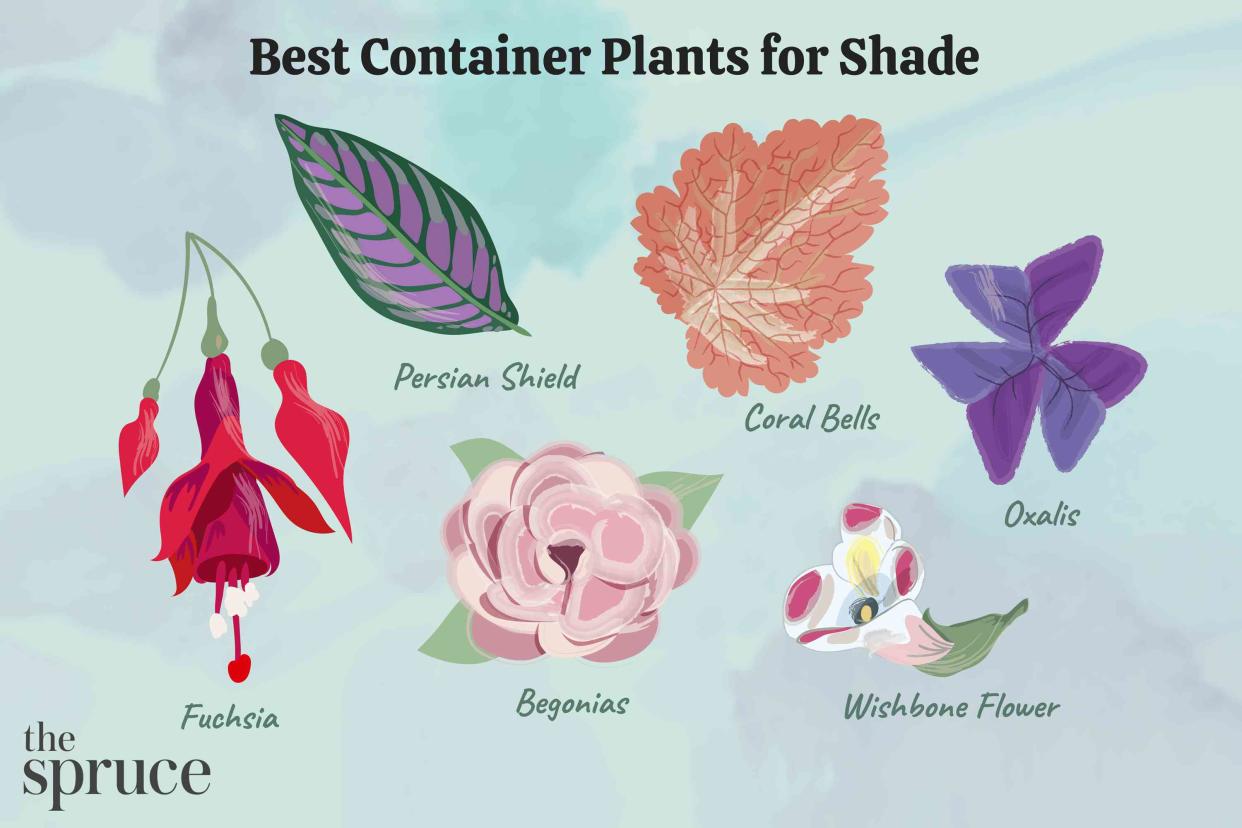
The Spruce
Reviewed by Debra LaGattutaFact checked by Alexandra Kay
Most plants can grow in containers, except some grow too large or have deep rooting systems. If you have a shady spot in your garden and want to add visual interest, a container garden with some shade-loving plants might be just what you need. Before getting plants for the spot, measure and observe how much sun the spot receives daily. Most plants need some sun. Very few plants, like impatiens, for example, are full-shade plants.
Partial Sun, Partial Shade, and Full Shade
Most shade-happy plants prefer "partial sun or partial shade." These two terms mean the same thing. These plants tolerate shade for most daylight hours but still need two to four hours of direct sunlight daily to thrive. Only plants rated as "full, dense, or deep shade" can thrive without zero direct sunlight. If direct sunlight is not possible for "partial sun or shade" plants, ensure they get several hours of filtered sunlight, much like they would if growing under a canopy of tall trees.
Here are 11 plants that work well for container plantings in shady locations.
Coleus (Plectranthus scutellarioides)
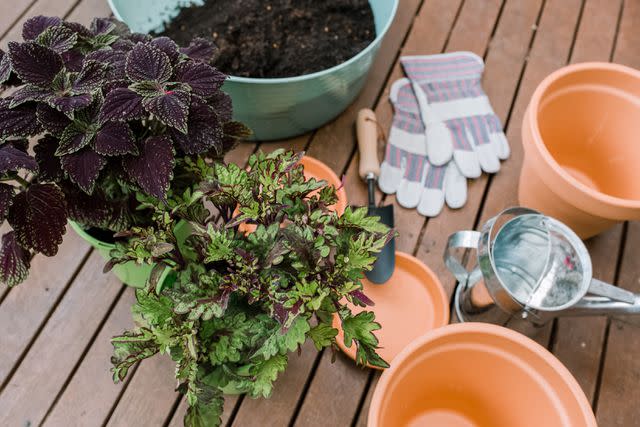
The Spruce / Kara Riley
Coleus (formerly Coleus blumei, currently recategorized botanically as Plectranthus scutellarioides) is one of the best-known shade plants. It is grown for its unique and interesting leaf colors rather than its blooms. Coleus genuinely thrives in full shade. New colors and leaf forms are being cultivated constantly. Some new varieties now thrive in partial shade and even in full sun.
The colors of coleus are intense, variegated, and patterned, requiring a gardener to be strategic when planning the rest of the garden and the blooms that might come. These plants can work beautifully with others or stand alone as specimen plants.
USDA Growing Zones: 10 to 11; usually grown as an annual
Color Varieties: Multi-colored foliage
Sun Exposure: Full shade to full sun, depending on the variety
Soil Needs: Rich, well-drained soil
Fuchsia (Fuchsia spp.)
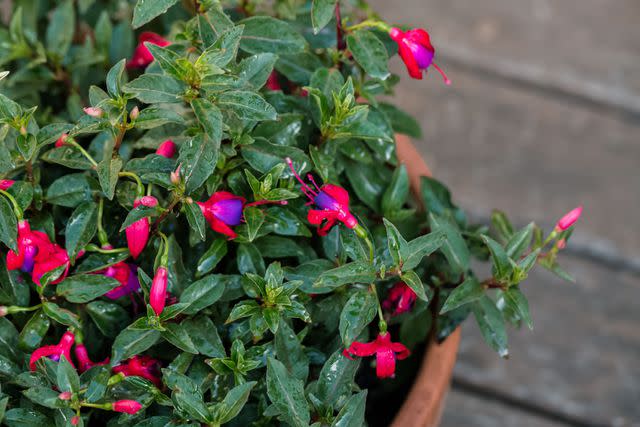
The Spruce / Kara Riley
Fuchsias are readily identifiable by their drooping, brightly colored flowers that bloom virtually all season. They look great paired with complementary or contrasting colors. Their trailing habit makes them excellent flowering plants for hanging baskets or mixed containers. There are 100 species in the Fuchsia genus, all of which put on a great display all summer, even in full shade. Some fuchsias have a reputation for fussiness, but most are easy to grow if they get water and fertilizer. If you live in a cold climate, bring it indoors to overwinter; otherwise, it will not survive the winter.
USDA Growing Zones: Typically 9 and warmer; usually grown as an annual
Color Varieties: Reds, pinks, violets
Sun Exposure: Part shade to full shade
Soil Needs: Rich, well-drained soil
Torenia (Torenia fournieri)
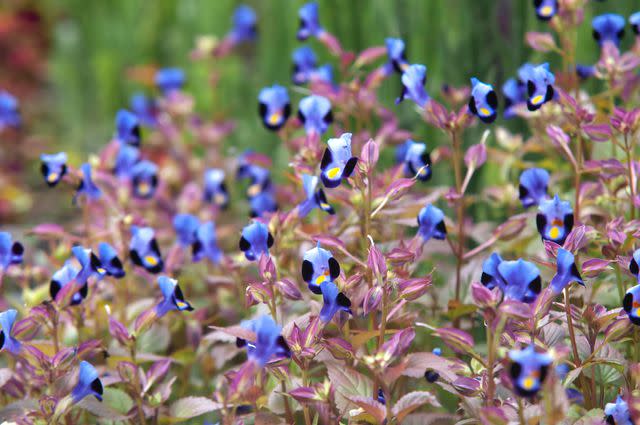
The Spruce / Evgeniya Vlasova
Torenia, also known as the wishbone flower, is an elegant and cheerful annual plant that will flower all summer, even in full shade. It is heat tolerant and straightforward to care for. This gem will thrive with regular watering and fertilizing until frost, and it doesn't need deadheading.
Wishbone flowers work well with other plants and in hanging baskets, window boxes, or any container with good drainage. They are relatively short, 6 to 18 inches, and will trail over the side of your container. In warm climates, torenia needs protection from the heat.
USDA Growing Zones: 2-11; annual or a houseplant in all climates
Color Varieties: Light to dark purple
Sun Exposure: Part shade to full shade
Soil Needs: Rich, well-drained soil
Coral Bells (Heuchera Species and Hybrids)
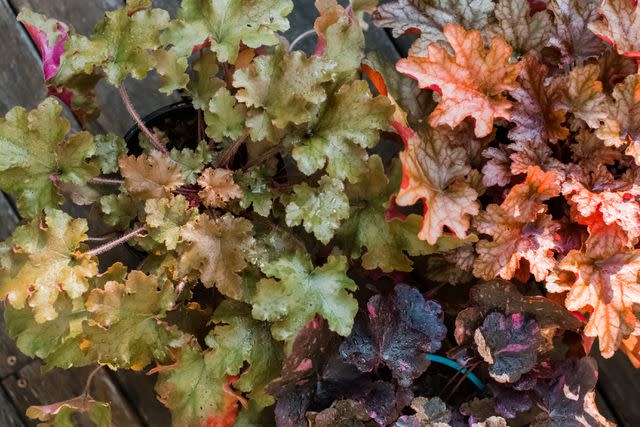
The Spruce / Kara Riley
Coral bells are gorgeous and almost indestructible standard garden perennials that work well for shady container gardens. Most thrive in the shade, tolerate some sun, and are quite drought-tolerant. Coral bell blooms are small and often indistinct, but their foliage comes in many unusual colors, ranging from an almost black purple to peach to bright key lime.
Coral bells attract hummingbirds and butterflies. Some are hardy to minus 25 degrees Fahrenheit and look amazing until the first snowfall. Deadheading is unnecessary, although if you remove flower stems after blooming, the plant will keep looking great.
Most commercial varieties are hybrids bred from parent species Heuchera americana, H. sanguinea, H. micrantha, H. villosa, or H. cylindrica. A few favorite varieties are 'Dolce Licorice', 'Dolce Key Lime Pie', and 'Dolce Creme Brulee'.
USDA Growing Zones: 4 to 9
Color Varieties: Dark purple to bright yellow-green foliage
Sun Exposure: Full sun to part shade (depending on variety)
Soil Needs: Rich, well-drained soil
Begonias (Begonia Groups and Hybrids)
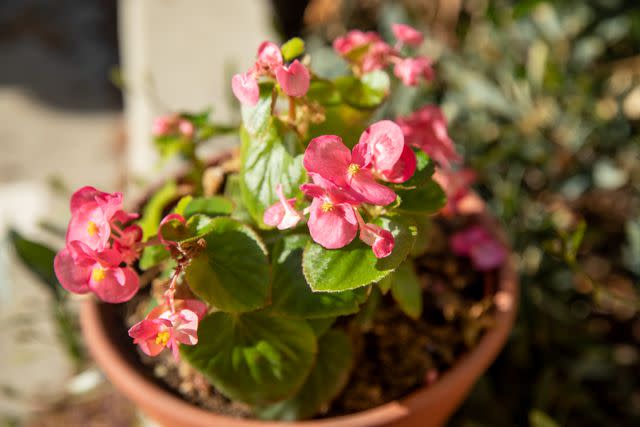
The Spruce / Krystal Slagle
Begonias have more than 1,800 species in their genus. The most popular container garden begonias are tuberous or rhizomatous with neon-bright flowers. Rex begonias are another popular variety with unique, psychedelic-looking leaf colors, shapes, and textures.
Many newly developed trailing, angel, and dragon-wing begonias bloom all summer. Most begonias require great drainage and can't tolerate wet feet. Some are happy in full shade, while some prefer filtered shade. Almost all flowering begonias must be fed regularly and generously with diluted fertilizer.
USDA Growing Zones: Typically 6 to 11, except for some hardy varieties
Color Varieties: White, orange, pink, red, and bicolor
Sun Exposure: Part shade to full shade
Soil Needs: Rich, well-drained soil
Persian Shield (Strobilanthes dyeranus)
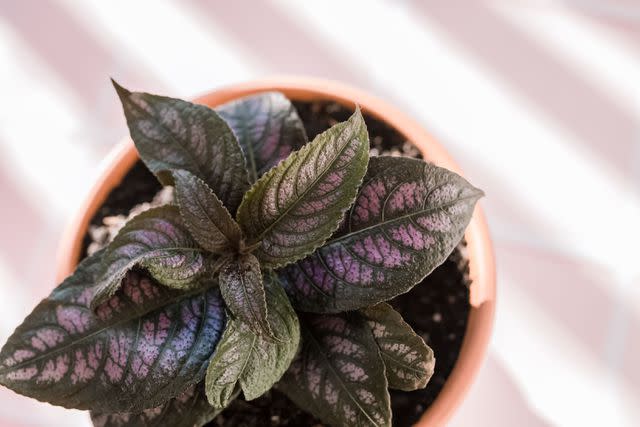
The Spruce / Kara Riley
Persian shield (Strobilanthes dyeranus) is a gorgeous foliage plant. It is a broadleaf evergreen perennial generally used as an annual. It features purple and silver blooms that stand out in any container. The plant towers up to 3 or 4 feet high and serves as a classic thriller plant.
Exceptionally easy to grow, Persian shield will add an exotic touch to your containers. It is uncommon and may be hard to find at garden centers. Buy it as soon as you see it; it often sells out. While Persian shield prefers a little sun, you can easily grow it in part shade. Pinching back the stems will keep the plant bushy and full.
USDA Growing Zones: 10 to 11; generally grown as an annual
Color Varieties: Purple and green/silver foliage
Sun Exposure: Bright light but not necessarily full sun
Soil Needs: Medium-moisture, well-drained soil
Oxalis (Oxalis spp.)
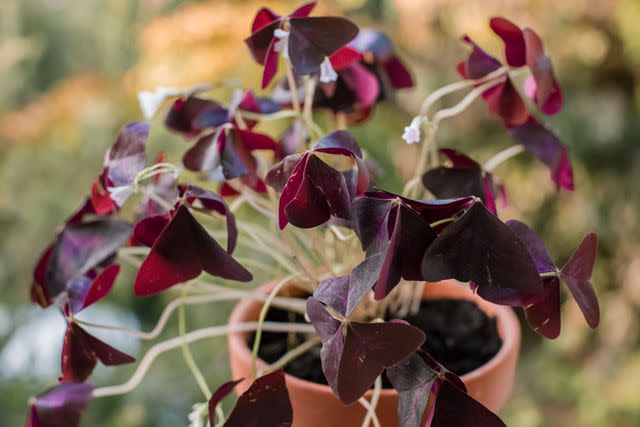
The Spruce / Kara Riley
Oxalis plants have delicate shamrock-shaped leaves and pretty tubular flowers that open and close as light exposure changes. This easy-to-grow plant is all about color and texture, works well with other plants, and looks good in a beautiful pot. In full shade, plant it with fuchsia or torenia; if in partial shade, it looks great with bacopa. In cold climates, you can bring your oxalis inside for the winter and turn it into a house plant.
Oxalis is another large genus of plants with several species good for shady containers, including Oxalis versicolor, O. triangularis, and O. tetraphylla. Flower colors are usually white, peach, yellow, pink, and bicolors. O. tetraphylla is mostly grown for its foliage.
USDA Growing Zones: 6 to 10, depending on species
Color Varieties: White, pink, yellow, peach, and bicolors
Sun Exposure: Full sun to part shade
Soil Needs: Average, well-drained soil
Impatiens (Impatiens walleriana)
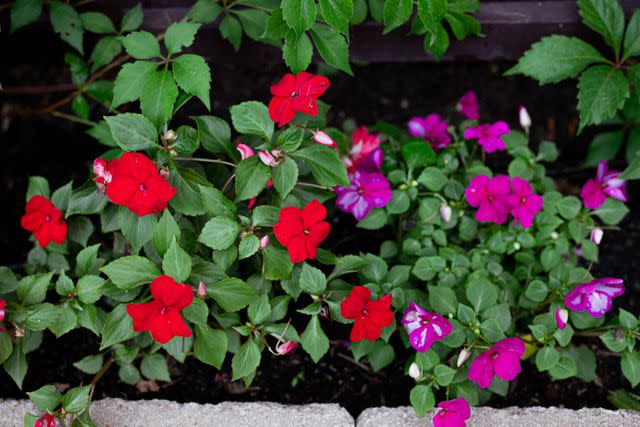
The Spruce / Autumn Wood
Impatiens walleriana is a shade favorite for a good reason—it is one of the few bright-flowering plants that thrive in full shade. Impatiens are available in a broad spectrum of white, pink, salmon, red, and purple hues, with single and double-petal flowers. These mounding plants are great in mixed pots and hanging baskets. The closely related New Guinea impatiens (Impatiens hawkeri) likes more sun, but it will also do well in partial shade.
Warning
Impatiens can't be planted in the ground in many places in the United States due to downy mildew disease, which can cause fungal spores to infect soils wherever the wind blows it. However, the disease does not affect impatiens planted in hanging baskets or containers with clean potting soil.
USDA Growing Zones: 10 to 11; generally grown as an annual
Color Varieties: Pink, red, lilac, purple, orange, white, and bi-colors
Sun Exposure: Part shade to full shade
Soil Needs: Rich, moist, well-drained soil
Trailing Lobelia (Lobelia erinus var. Pendula)
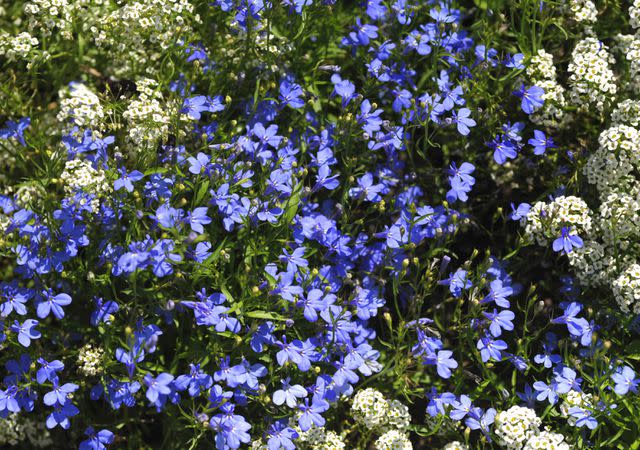
The Spruce / Evgeniya Vlasova
Lobelia is an extensive genus of plants, with many species that prefer direct sun. But the trailing version (Lobelia erinus var. pendula) is an ideal plant for shady containers. L. erinus is commonly known as "edging lobelia," the pendula variation puts out long, cascading shoots ideal in hanging baskets and pots. Various cultivars are available in multiple flower colors, including blue, violet, purple, red, and pink.
USDA Growing Zones: 7 to 11; generally grown as an annual
Color Varieties: Blue/violet, red, pink
Sun Exposure: Full sun to partial shade
Soil Needs: Rich, moist, well-drained soil
Dichondra (Dichondra Argentea)
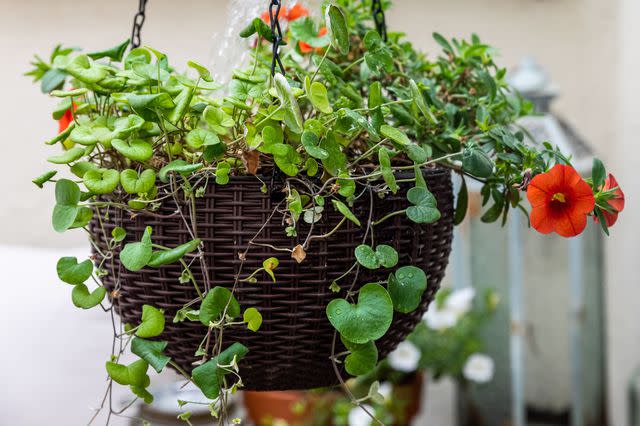
The Spruce / Jayme Burrows
Dichondra is a creeping, trailing, evergreen perennial plant in warm climates. It is commonly used as a trailing spiller plant in containers. It is generally grown for its foliage, not its flowers. Although it's a sun-lover, this plant tolerates partial shade and works well if it gets just an hour or two of sun each day.
Dichondra grows only about 4 inches high but sends out shoots up to 4 feet long, making it ideal for hanging baskets, tall containers, and window boxes. One popular cultivar, 'Silver Falls,' has shimmering silvery foliage and stems. Although drought-tolerant in the garden, it should be kept well watered when grown in containers.
USDA Growing Zones: 10 to 12; customarily grown as an annual
Color Varieties: Green or silver foliage
Sun Exposure: Full sun to partial shade
Soil Needs: Medium-moisture soil
Creeping Jenny (Lysimachia nummularia)
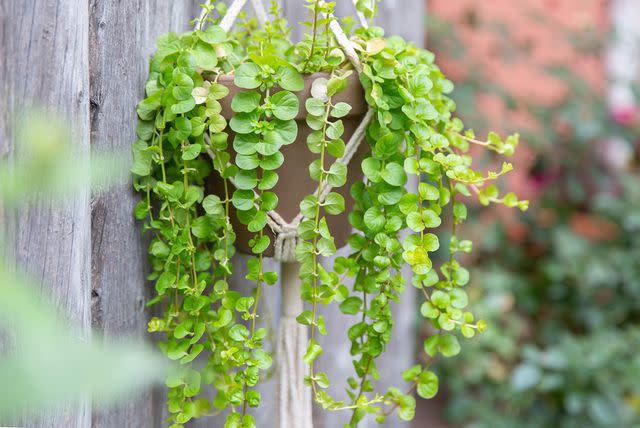
The Spruce / Candace Madonna
Not all container plants need to be flowering plants. Creeping jenny is a mat-forming perennial with round lime-green leaves that works well in tall containers or hanging baskets. It grows only 2 to 4 inches tall but sends out in shoots up to 2 feet long. It is a perfect spiller plant for the outside edges of containers or hanging baskets, where the light-green foliage can brighten shady areas.
This perennial plant is better suited for containers since it can be invasive if planted in the garden.
USDA Growing Zones: 3 to 9
Color Varieties: Yellow flowers, but usually grown for their green or yellow leaves
Sun Exposure: Full sun to part shade
Soil Needs: Rich, well-drained soil
Frequently Asked Questions
What is the best potted plant for shade?
Impatiens are one of the best potted plants for shade, producing beautiful, colorful flowers whether they have any sun or not.
What are the best spillers for shade?
Begonias, fuschia, and creeping jenny are outstanding shady container garden spiller choices.
What is the best trailing plant for shade?
Trailers and spillers mean the same thing; besides begonias and fuchsias, oxalis, dichondra, and trailing lobelia are other wonderful cascading, vine-like plants.
Read the original article on The Spruce.

